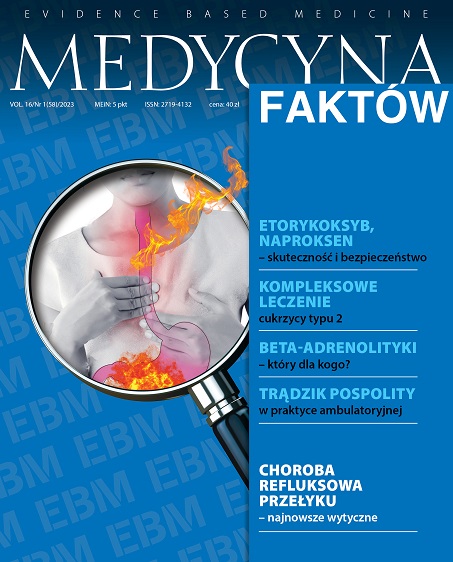Przełykowe i pozaprzełykowe objawy choroby refluksowej przełyku – postępowanie w świetle najnowszych wytycznych Artykuł przeglądowy
##plugins.themes.bootstrap3.article.main##
Abstrakt
Choroba refluksowa przełyku należy do najczęstszych chorób górnego odcinka przewodu pokarmowego. Jak wynika z aktualnych badań, dotyczy ona ok. 20–23% populacji osób dorosłych w krajach Europy Zachodniej i Ameryki Północnej. Największe wyzwania i problemy w leczeniu to nietypowe objawy, objawy pozaprzełykowe i oporność na farmakoterapię, głównie inhibitorami pompy protonowej, które są podstawową grupą leków w tym wskazaniu. Brak skuteczności ich działania dotyczy 17–45% pacjentów. Jeśli mimo zastosowania inhibitorów pompy protonowej dolegliwości się utrzymują, możliwe są podwojenie dawki lub zamiana preparatu na inny, ewentualnie dodanie blokera receptora H2, alginianu, sukralfatu lub leku prokinetycznego. Z tego powodu w ostatnim czasie pojawiły się nowe zalecenia mające zwiększyć skuteczność terapii. W 2021 r. ukazały się łączone wytyczne europejskie i amerykańskie dotyczące postępowania w chorobie refluksowej opornej na leczenie, a w 2022 r. Polskie Towarzystwo Gastroenterologii opublikowało wytyczne leczenia choroby refluksowej. W pracy podsumowano najważniejsze ustalenia powyższych dokumentów.
##plugins.themes.bootstrap3.article.details##
Copyright © by Medical Education. All rights reserved.
Bibliografia
2. Ziółkowski BA, Pacholec A, Kudlicka M et al. Prevalence of abdominal symptoms in the Polish population. Prz Gastroenterol. 2012; 7: 20-5.
3. Vakil N, van Zanten SV, Kahrilas P et al. The Montreal definition and classification of gastroesophageal reflux disease: a global evidence based on the consensus. Am J Gastroenterol. 2006; 101: S1-S16.
4. Lovell RM, Ford AC. Prevalence of gastro-esophageal reflux type symptoms in individuals with irritable bowel syndrome in the community: a meta-analysis. Am J Gastroenterol. 2012; 107: 1793-801.
5. de Bortoli N, Martinucci I, Bellini M et al. Overlap of functional heartburn and gastroesophageal reflux disease with irritable bowel syndrome. World J Gastroenterol. 2013; 19: 5787-97.
6. Gąsiorowska A, Janiak M, Waśko-Czopnik D et al. Postępowanie u pacjentów z objawami choroby refluksowej przełyku – rekomendacje dla lekarzy rodzinnych. Lekarz POZ. 2019; 3/4: 245-65.
7. Kahrilas P, Shaheen NJ, Vaezi MF. American Gastroenterological Association Institute technical review on the management of gastroesophageal reflux disease. Gastroenterology. 2008; 135: 1392-413.
8. Katz PO, Gerson LB, Vela M. Guidelines for the diagnosis and management of gastroesophageal reflux disease. Am J Gastroenterol. 2013; 108: 308-28.
9. Moore JM, Vaezi MF. Extraesophageal manifestations of gastroesophageal reflux disease: real or imagined? Current Opin Gastroenterol. 2010; 26: 389-94.
10. Vaezi MF. Therapy insight: gatroesophageal reflux disease and laryngopharyngeal reflux. Nat Clin Pract Gastroenterol Hepatol. 2005; 2: 595-603.
11. Iwakiri K, Kinoshita Y, Habu Y et al. Evidence-based clinical practice guidelines for gastroesophageal reflux disease 2015. Am J Gastroenterol. 2016; 51: 751-67.
12. Gyawali CP, Kahrilas PJ, Savarino E. Modern diagnosis of GERD: the Lyon Consensus. Gut. 2018; 67: 1351-62.
13. Sifrim D, Zerbib F. Diagnosis and management of patients with reflux symptoms refractory to proton pump inhibitors. Gut. 2012; 61: 1340-54.
14. Gyawali CP, Fass R. Management of Gastroesophageal Reflux Disease. Gastroenterology. 2018; 154: 302-18.
15. Spechler SJ, Sharma P, Souza RF et al. Association AG. American Gastroenterological Association medical position statement on the management of Barrett’s esophagus. Gastroenterology. 2011; 140: 1084-91.
16. Shaheen NJ, Falk GW, Iyer PG et al. ACG Clinical Guideline: Diagnosis and Management of Barrett’s esophagus. Am J Gastroenterol. 2016; 111: 30-50.
17. Vaezi MF, Pandolfino JE, Vela MF et al. White paper AGA: Optimal strategies to define and diagnose gastroesophageal reflux disease. Clin Gastroenterol Hepatol. 2017; 15: 1162-72.
18. Savarino E, Zentilin P, Mastracci L et al. Microscopic esophagitis distinguishes patients with non-erosive reflux disease from those with functional heartburn. J Gastroenterol. 2013; 48: 473-82.
19. Trudgill NJ. British Society of Gastroenterology guidelines for esophageal manometry and esophageal reflux monitoring. Gut. 2019; 66: 1-20.
20. Mittal R, Vaezi MF. Esophageal motility disorders and gastroesophageal reflux disease. N Engl J Med. 2020; 383: 1961-72.
21. Vaezi MF, Pandolfino JE, Yadlapati RH et al. ACG guidelines: diagnosis and management of achalasia. Am J Gastroenterol. 2020; 115: 1393-411.
22. Vaezi MF, Sifrim D. Assessing old and new diagnostic tests for gastroesophageal reflux disease. Gastroenterology. 2018; 154: 289-301.
23. Saleh CM, Smout AJ, Bredenoord AJ. The diagnostic of gastro-esophageal reflux disease cannot be made with barium esophagograms. Neurogastroenterol Motil. 2015; 27: 195-200.
24. Katzka DA, Pandolfino JE, Kahrilas PJ. Phenotypes of gastroesophageal reflux disease: Where Rome, Lyon and Montreal meet. Clin Gastroenterol Hepatol. 2019; 2: 24-35.
25. Boeckxstaens G, El-Serag HM, Smout A et al. Symptomatic reflux disease: the present, the past and the future. Gut. 2014; 63(7): 1185-93.
26. Mahoney LB, Rosen R. The spectrum of reflux phenotypes. Gastroenterol Hepatol. 2019; 15(12): 646-54.
27. Gąsiorowska A. Ochrona i regeneracja błony śluzowej przełyku, gardła i krtani jako ważny element terapii u pacjentów z przełykowymi i pozaprzełykowymi objawami choroby refluksowej. Otolaryngol Pol. 2020; 74(4): 40-5.
28. Haastrup PF, Thompson W, Sondegaard J et al. Side effects of long-term proton pump inhibitor use: a review. Basic Clin Pharmacol Toxicol. 2018; 123: 114-22.
